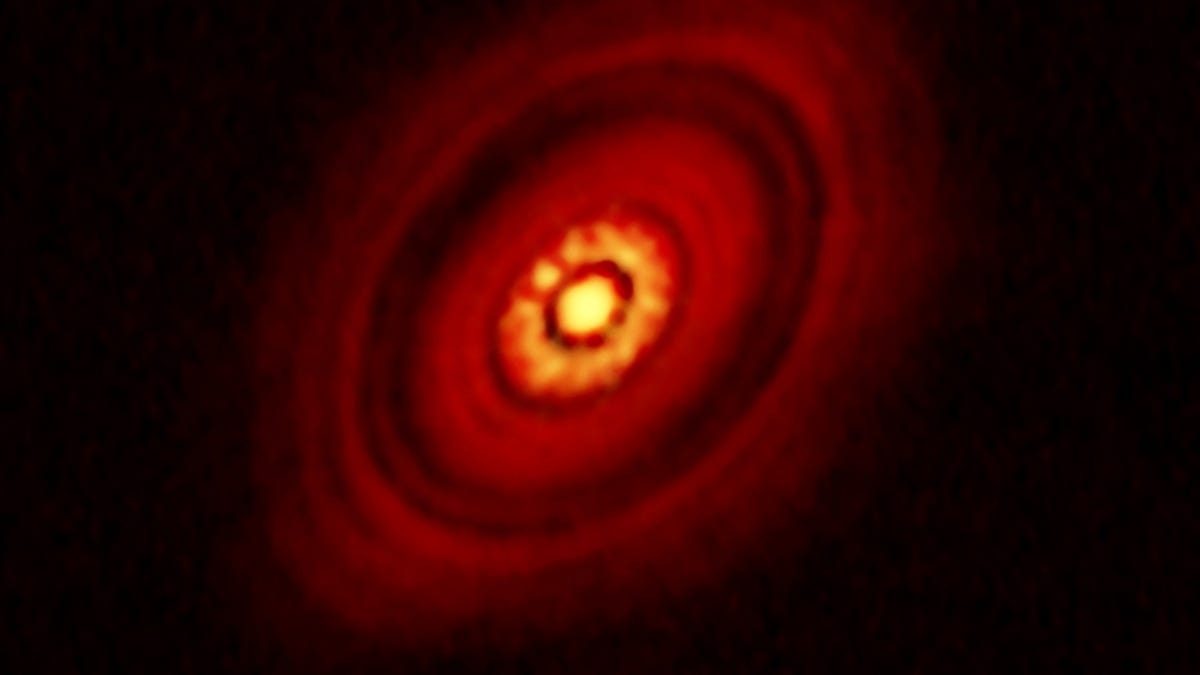Scientists find a planet so young it isn't even really a planet yet
The earliest stage of planetary development ever seen has been found in a disc of dust around a new star imaged in 2014.
An image taken using the Atacama Large Millimeter /submillimeter Array in Chile and released in 2014 shows something rather special. It's a disc, taken from an angle, with concentric striations. At the centre is the very young star HL Tau, just a million years old, 450 light-years from Earth in the constellation of Taurus. The striated disc is the protoplanetary disc of dust and gas, coalescing into a planetary system around HL Tau.
The gaps in the disc are thought to have been cleared by larger planetary bodies in the dust. The ALMA study was the clearest view yet of this long-theorised process.
However, while ALMA could see more detail in the outer disc, the inner dusty regions were opaque to ALMA's sensors. So an international team of scientists used the Karl F Jansky Very Large Array radio telescope located in New Mexico. The VLA is capable of detecting longer wavelengths than ALMA, and could view the inner ring in finer detail.
And it found something. Close to the star, VLA found a clump in the innermost region of the disc, sized at roughly three to eight times the size of the earth. A baby planet.
"We believe this clump of dust represents the earliest stage in the formation of protoplanets, and this is the first time we've seen that stage," said study co-leader Thomas Henning of the Max Planck Institute for Astronomy in a statement.
Planets are a lot harder to study than stars, because they do not give off any visible light or radiation on their own. We can only study them based on reflected or absorbed and re-emitted radiation from stars, which is a lot weaker than what the stars themselves give off. Viewing a planet directly is very rare, and a protoplanet even rarer.
"This is an important discovery, because we have not yet been able to observe most stages in the process of planet formation," explained study co-leader Carlos Carrasco-Gonzalez from the Institute of Radio Astronomy and Astrophysics of the National Autonomous University of Mexico.
The ALMA image on the left, and the VLA image on the right showing the protoplanet.
"This is quite different from the case of star formation, where, in different objects, we have seen stars in different stages of their life cycle. With planets, we haven't been so fortunate, so getting a look at this very early stage in planet formation is extremely valuable."
Planets actually form from very tiny elements. Around HL Tau, the inner region of the disc contains grains only up to about one centimetre in diameter, based on the VLA data. As the disc swirls in orbit around the star, some of these clumps will start to stick together, forming a tiny planet, called a planetesimal. The bigger a clump grows, the more it attracts other clumps, eventually developing a stronger gravitational pull of its own and clearing the area around it.
Eventually the new planet will have a clear path of orbit around its star. The main asteroid belt in the solar system, between Mars and Jupiter, is thought to be a remnant of this process, made up of planetesimals that were too disrupted by Jupiter's gravity to form planets, colliding instead into an asteroid field.
Getting to see this process first-hand is exciting, and will allow many new insights into how planets form. The team's paper, which will be reported in the Astrophysical Journal Letters, can be read on arXiv.


